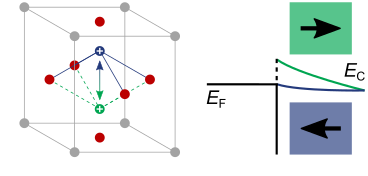Ferroelectric Switching

In ferroelectric materials, the unit can adopt two different stable configurations, for example, as illustrated in the image, where the centre ion is stable in the upper and the lower position, and the application of a suitable external electric field can switch this position. On a macroscopic scale, in a (mono- or poly-)crystalline thin film, if the majority of unit cells is polarised in the same direction, this results in the spontaneous polarisation of the thin film, i.e., a polarisation which persists even after the external electric field is removed. For memory and neuromorphic devices, this can be used in different ways. Recently, we demonstrated how depending on the polarisation, an interface barrier towards an adjacent electrode can change from a Schottky to an Ohmic contact. The resulting high and low conductance across the thin film can be identified with information.
